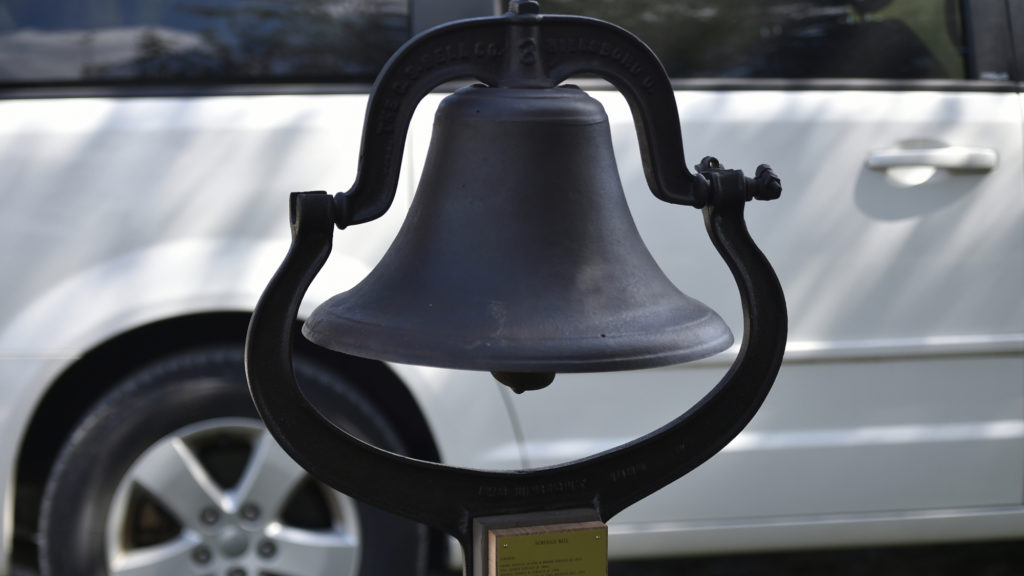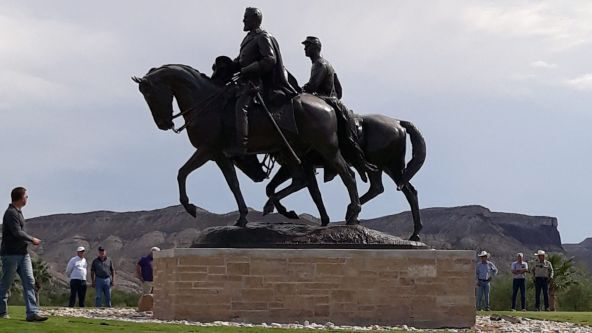Dallas’ embattled Robert E. Lee statue has a new home—a remote golf resort on the Rio Grande River in Southwest Texas. The bronze statue, created in the early 1930s by American sculptor Alexander Phimster Proctor, features Lee on his horse, Traveller, accompanied by a young Confederate officer representing Southern youth. In 1936, the Lee statue was unveiled to the public at Dallas’ Oak Lawn Park by President Franklin D. Roosevelt. Afterwards, the park’s name was changed to Lee Park in honor of the Confederate general.
In the tragic wake of the Charleston, South Carolina church shootings and the death of a young protestor in Charlottesville, Virginia, the Dallas City Council voted 13 to 1 to remove the statue from the city’s Lee Park in August, 2017. Upon removal, the statue was placed in storage at Hensley Field in Grand Prairie, Texas, a former army and naval air station owned by the City of Dallas. To recoup the removal expenses, the council sold the statue off at auction to a Dallas law firm for $1,435,000. As part of the sale, the new owner could not display the statue publicly within the Dallas Fort Worth area.
Shortly after its purchase, the statue was donated to the Lajitas Golf Resort in Texas’ Big Bend country between Big Bend National Park and Big Bend State Park. The resort, owned by Dallas oil billionaire Kelcy Warren, placed the statue in the middle of a putting green at the Black Jack’s Crossing Golf Course.
Scott Beasley, president of Dallas-based WSB Resorts and Clubs, stated, “It was donated to the resort, and we could not be a more proud recipient.”—Donald T. Barnhart
Bell That Tolled for Freedom Returns Home
A 70-pound brass bell that has been passed down through five generations of a family with its roots in slavery has been returned home to an Appomattox, Va., woman after ringing its way through a tour of historic celebrations.

Stored for generations on the family farm, first on a stand behind the smokehouse and later in the basement, the bell helped to commemorate events such as the 150th anniversary of General Robert E. Lee’s surrender at Appomattox Court House in 2015; the 2017 opening of the Harriet Tubman Underground Railroad Visitor Center in Maryland; and in a “healing ceremony” at Fort Monroe, Va., on the 400th anniversary of the arrival of the first Africans on Virginia’s shores this past summer.
The bell has been dated back to at least 1866, but owner Ora McCoy, 76, said she is not sure of its exact history. It’s been a part of her family since her great-great-grandparents, Daniel and Phoebe Scruggs, were slaves on the Scruggs family farm during the Civil War, she told the Roanoke Times.
McCoy noted that her ancestor Phoebe Scruggs not only lived to be a free woman, but to have a house and autonomy.
“I take pride in that. Because the struggle that my great-great-great grandmother went through, she never could have seen this day. But because of the fact that we’re here, we’re living in this day, there is transition available. But there has to be something to ring in the change,” McCoy’s nephew, R. Stuart Jones, told the Roanoke Times. “Our bell is helping to ring in the change.”
Cleaner drinking water—a byproduct of battlefield preservation?
The September 19-20, 1862, Battle of Shepherdstown was the site of the bloodiest battle in present-day West Virginia, with more than 600 Union and Confederate casualties following the Battle of Antietam across the Potomac River in Maryland.
Today, though, the site is an example of a happy marriage between the preservation of Civil War battlefields and clean drinking water for local residents and those downstream.
Because the Shepherdstown site is a protected historic landmark, about a half-mile of Potomac River frontage falls under the management of the Jefferson County Historic Landmarks Commission. Two years ago, that group joined with the Jefferson County Farmland Protection Board, the Berkeley County Farmland Protection Board, and the West Virginia Rivers Coalition to create an initiative called the Safe Water Conservation Collaborative in the Eastern Panhandle.
The initiative uses land conservation easements to protect drinking water by preventing development or other contamination threats. Other activities on the battlefield site such as controlling runoff and planting trees further contribute to improving water quality.
“When we protect land, we’re not just protecting cropland. We’re protecting woodland, we’re protecting streams, we’re protecting historic resources, so it fits into what we do; to be able to contribute to source water protection,” said Liz Wheeler, director of the Jefferson County Farmland Protection Board, the organization that administers conservation easements to protect historic farmland and battlefields in Jefferson County.
The groups hope their initiative will serve as a model for other conservation groups across the state and beyond.
Update on North Carolina History Center project
Even though they’ve agreed to the funding, some city and county politicians are having second thoughts about the planned North Carolina Civil War & Reconstruction History Center in Fayetteville.
The local governments had each approved $7.5 million in 2016, money that’s essential to leveraging funding from the state. According to Mac Healy, president of the history center’s foundation, the museum would lose $46 million in state funding if the local funding is withdrawn. “We’d lose everything,” he told The Fayetteville Observer.
It’s anticipated that the museum would create about 200 full-time jobs and produce an economic benefit of about $20 million a year, according to David Winslow, president of the history center project. The History Center is designed to be a “teaching museum” rather than a “collecting museum.”
Fayetteville Mayor Mitch Colvin says he isn’t “closing the door” on the proposed museum, but suggests he would like another name that will not be offensive to the African American community. Some council members also expressed concerns, though others have expressed support. Cumberland County officials have said their funding is contingent on the city’s.
The project has moved forward with the assistance of a who’s who of prominent African American scholars and academics, with the stated goal: “To understand the sacrifice and service wrought by all North Carolinians, the History Center will provide an in-depth, immersive interpretive experience that accurately portrays the immense difficulties and challenges of life…on the North Carolina Civil War home front. Soldiers, civilians, landowners, yeoman farmers, slaves, runaways, freedmen, Native Americans, men, women, and children…each and every North Carolinian paid a price for the Civil War and Reconstruction. The History Center is here to tell their stories.”
“The only thing you can do in life is tell the truth,” says Healy, “and that’s why we had experts write this [curriculum].”
City and county votes on the museum’s support are anticipated over the next months.
D.P. Newton, curator of White Oak Civil War Museum, dies
D.P. Newton, an avid Civil War relic hunter and curator of the White Oak Civil War Museum in Falmouth, Va., died October 15, 2019. He was 66.
Newton, a self-taught historian, created the museum to house the thousands of Civil War artifacts he and his father collected in Stafford County. Father and sons spent many days using metal detectors to comb areas of the county, home to numerous Union army camp including major installations at Falmouth and Aquia Creek.
The collection included thousands of Minie balls, belt buckles, buttons, bayonets, caps and other military items. Newton also collected maps, letters, and diaries that allowed him to tell visitors, whom he guided through the museum personally, in detail about the lives of soldiers stationed in Stafford.
The museum is at 985 White Oak Road. Its four rooms of exhibits remain open Wednesday to Saturday. Admission is $4.





